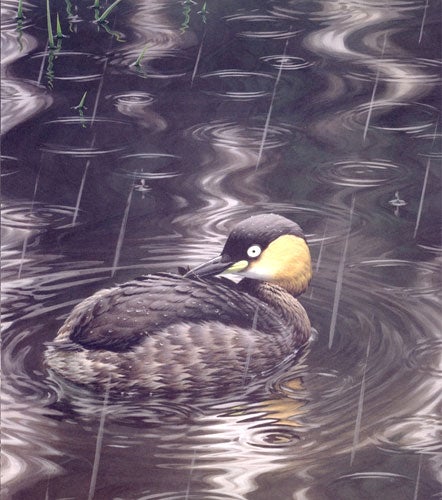End of Alaotra grebe is further evidence of Sixth Great Extinction
Species are vanishing quicker than at any point in the last 65 million years

One more step in what scientists are increasingly referring to as the Sixth Great Extinction is announced today: the disappearance of yet another bird species. The vanishing of the Alaotra grebe of Madagascar is formally notified this morning by the global conservation partnership BirdLife International – and it marks a small but ominous step in the biological process which seems likely to dominate the 21st century.
Researchers now recognise five earlier cataclysmic events in the earth's prehistory when most species on the planet died out, the last being the Cretaceous-Tertiary extinction event of 65 million years ago, which may have been caused by a giant meteorite striking the earth, and which saw the disappearance of the dinosaurs.
But the rate at which species are now disappearing makes many biologists consider we are living in a sixth major extinction comparable in scale to the others – except that this one has been caused by humans. In essence, we are driving plants and animals over the abyss faster than new species can evolve.
Birds species alone now seem to be disappearing at the rate of about one per decade, and the extinction of the Alaotra grebe is announced in the BirdLife-produced update to the Red List of threatened bird species maintained by the International Union for the Conservation of Nature (IUCN).
A handsome bird not dissimilar to our own little grebe or dabchick, it inhabited a tiny area in the east of Madagascar, and declined after carnivorous fish were introduced into the freshwater lakes where it lived, and fishermen began using nylon gillnets which caught and drowned the birds. Its demise brings the total number of bird species thought to have become extinct since 1600 to 132.
Moreover, the new edition of the Red List shows that 1,240 species of birds (around an eighth of the 10,027 total) are themselves now in danger of disappearance – which is a rise of 21 from last year's assessment.
"The confirmation of the extinction of yet another bird species is further evidence that we losing the fight to protect the world's wildlife," said Dr Tim Stowe, international director of the Royal Society for the Protection of Birds. "Although there are some key successes, overall the trend is downward, bringing more species year on year to the brink of extinction and beyond."
Known only in Madagascar, and chiefly from Lake Alaotra, Tachybaptus rufolavatus was probably incapable of prolonged flight, so may never have occurred very far from the lake itself. None have been seen since 1999 and the most recent surveys in the region failed to find any birds.
"No hope now remains for this species," said Dr Leon Bennun, BirdLife's director of science, policy and information, announcing the change in its classification from critically endangered to extinct. "It is another example of how human actions can have unforeseen consequences. Invasive alien species have caused extinctions around the globe and remain one of the major threats to birds and other biodiversity."
Another wetland species suffering from the impacts of introduced aliens is the Zapata rail from Cuba, whose status has now been moved up to critically endangered and is under threat from introduced mongooses and exotic catfish. An extremely secretive marsh-dwelling species, the only nest ever found of this species was described by James Bond, an American ornithologist and the source for the name of Ian Fleming's famous spy.
(The real James Bond was the author of Birds of The West Indies and Fleming, himself a keen birdwatcher, had a copy of the book in his Jamaican hideaway, Goldeneye, where he wrote the Bond novels.)
In fact, BirdLife says, wetland birds everywhere are under increasing pressure. In Asia and Australia, numbers of once-common wader species such as the great knot and Far Eastern curlew are dropping rapidly as a result of drainage and pollution of coastal wetlands. The destruction of inter-tidal mudflats at Saemangeum in South Korea, an important migratory stop-over site, correlated to a 20 per cent decline in the world population of great knot.
There is, however, a little good news in the new Red List. The Azores bullfinch, has been downlisted from Critically Endangered to Endangered as a result of conservation work to restore natural vegetation on its island home of Sao Miguel; the Chatham albatross from New Zealand has also been downlisted from Critically Endangered to Vulnerable following an improvement in the bird's status, and the Laysan albatross is removed from the list following a similar improvement.
Earth's Five Great Extinctions
65 million years ago (mya) Cretaceous-Tertiary (K-T extinction). Did for the dinosaurs. May have been caused by a meteorite hitting what is now Yucatan, Mexico; 75 per cent of species disappeared.
205 mya Triassic-Jurassic extinction. Did away with competition for the dinosaurs.
251mya Permian-Triassic (the worst of all). Known as "The Great Dying." About 96 per cent of marine species and 70 per cent of land species disappeared.
360-375mya Late Devonian. A prolonged series of extinctions which may have lasted 20 million years.
440-450mya Ordovidician-Silurian. Two linked events which are considered together to have been the second worst extinction in the list.
Join our commenting forum
Join thought-provoking conversations, follow other Independent readers and see their replies
Comments